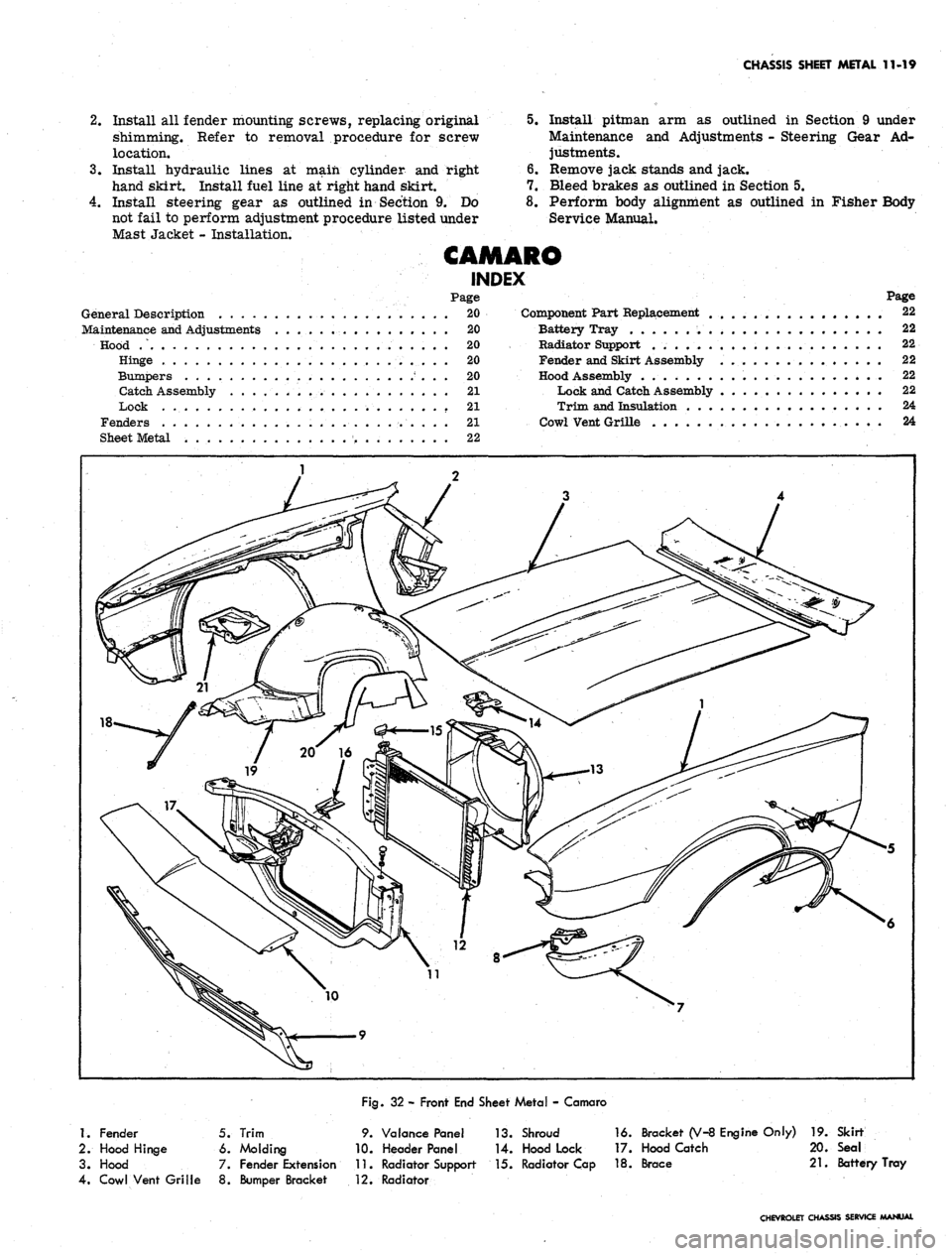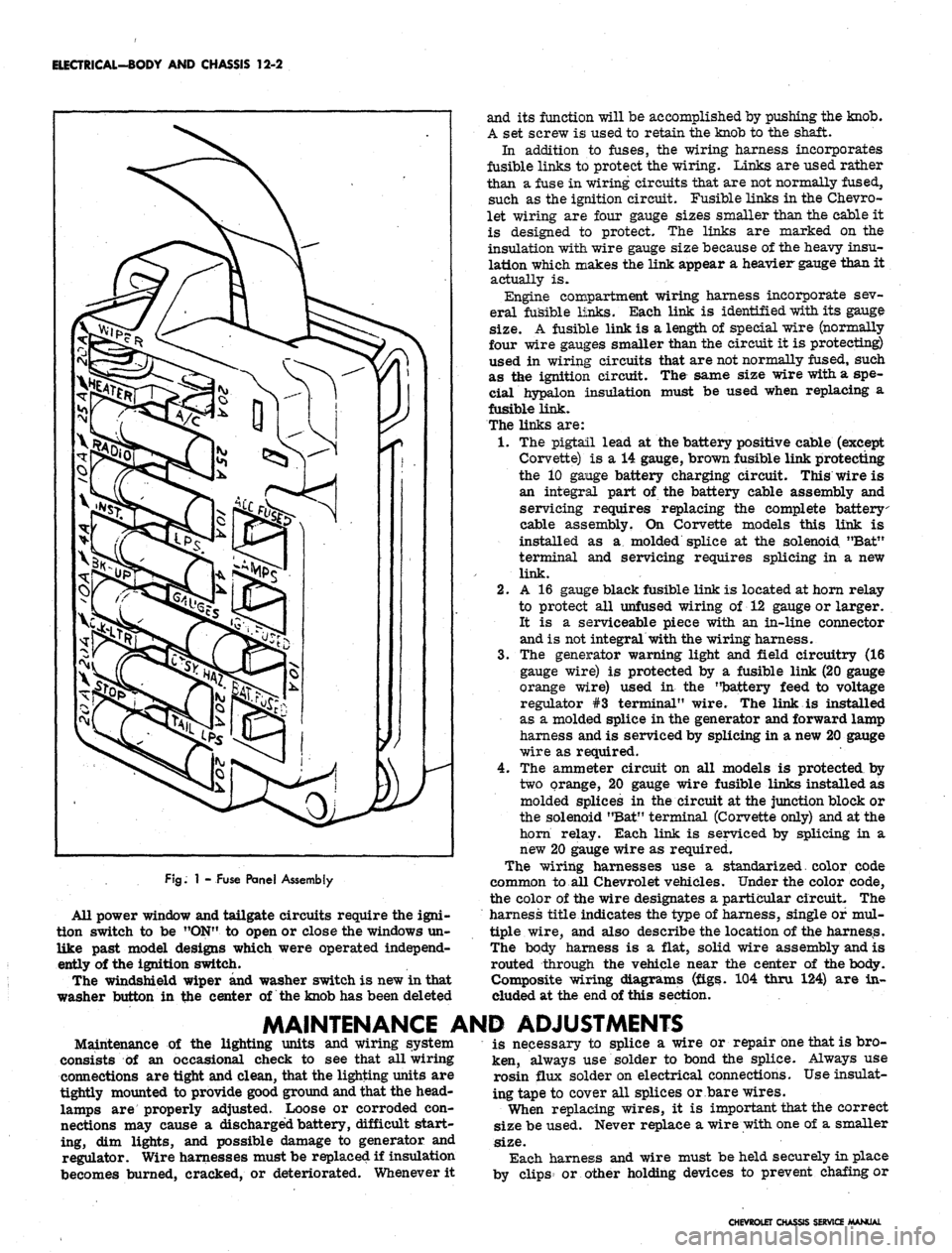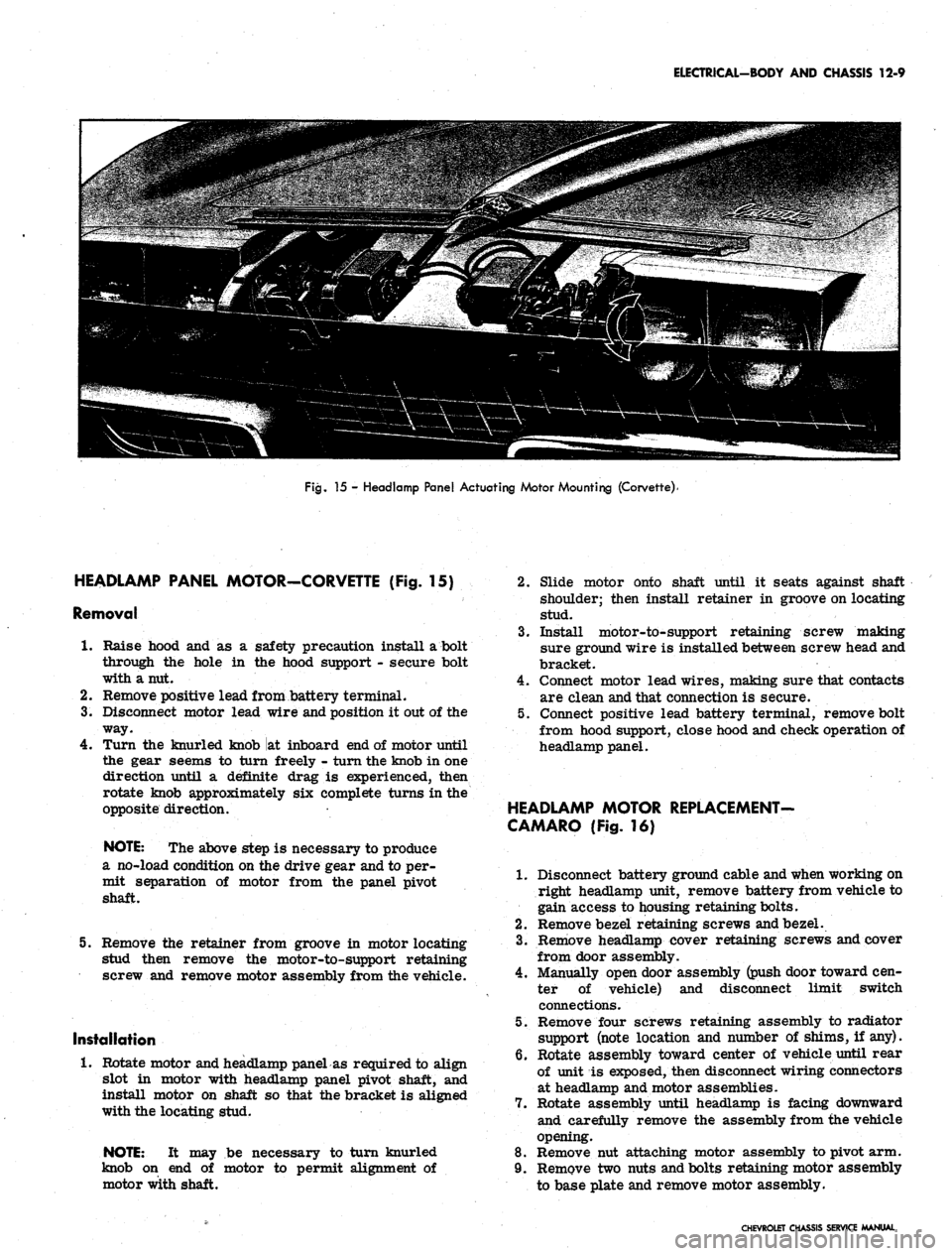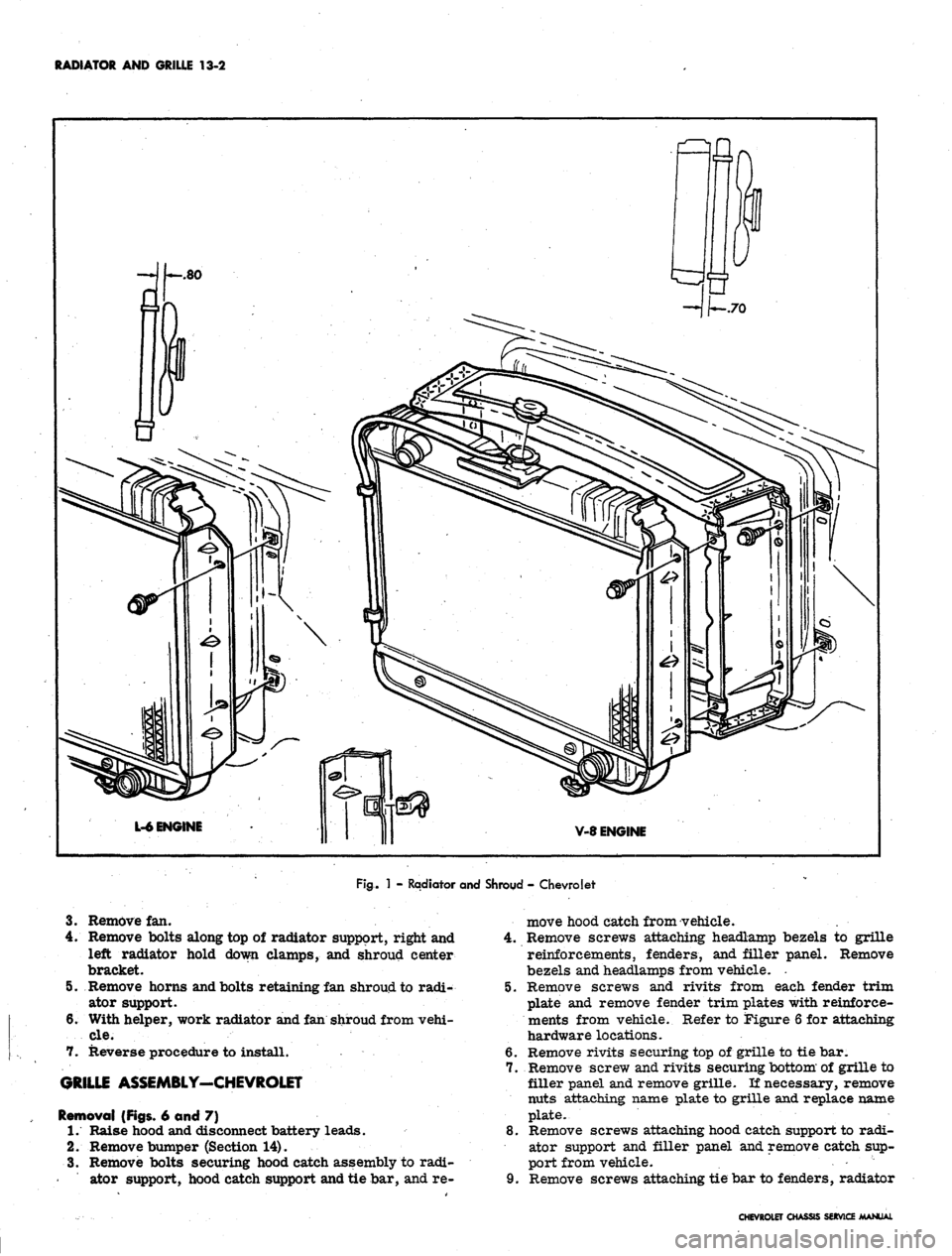battery location CHEVROLET CAMARO 1967 1.G Chassis User Guide
[x] Cancel search | Manufacturer: CHEVROLET, Model Year: 1967, Model line: CAMARO, Model: CHEVROLET CAMARO 1967 1.GPages: 659, PDF Size: 114.24 MB
Page 501 of 659

CHASSIS SHEET METAL 11-14
location is shimmed; thus keeping the fender mount-
ing bolts from crushing in the fender mounting
flange.
If shimming is done without the fenders being disas-
asembled, it is suggested that fender mounting bolts
rearward of radiator support be loosened while shims
are inserted and sheet metal fit is checked. Tighten
shimmed mounting bolts first, then all others.
COMPONENT PART REPLACEMENT
BATTERY TRAY (FIG. 21)
Removal
1.
Disconnect battery cables.
2.
Remove screw retaining battery hold down clamp.
3.
Remove battery from vehicle.
4.
Remove screws retaining tray assembly to fender
skirt and support, and remove tray from vehicle.
Installation
Reverse removal procedure.
RADIATOR SUPPORT (FIG. 22)
Removal
1.
Remove grille and related components (Section 13).
Remove battery tray as outlined in this section.
Remove shroud attaching screws and remove shroud
if vehicle is so equipped.
Remove horn relay, horns, voltage regulator, and
wiring harness from radiator support.
Remove shroud and radiator (Section 13)o
Remove screws attaching radiator support to frame,
skirts,
fenders.
Remove radiator support from vehicle (fig. 23).
Installation
1.
Position radiator support in vehicle; align mounting
screw and bolt holes with drift punch.
Install screws and bolts loosely until all are started,
then tighten.
3.
Complete installation following removal procedure in
reverse order. Refer to torque specifications at rear
of manual for correct torque values.
4.
Aim headlamps as outlined in Section 12.
FRONT FENDER ASSEMBLY
Removal
1*
Remove headlamp dooro
2.
Open hood and remove screws joining fender top
2.
Fig. 20 - Front Fender Shimming
Fig.
21 - Battery Tray
flange to skirt. Remove, and record number of
shims at first cap screw forward of windshield (fig.
24).
3.
Remove screw located on upper surface of headlamp
cavity.
4.
From under forward end of fender, remove screw
retaining fender to radiator support.
5.
From inboard side of rocker panel extension, remove
cap screw retaining fender to extension. Remove,
and record number of shims.
6. Separate headlamp filler panel from fender by re-
moving remaining screws.
7.
Remove fender from vehicle.
Installation
1.
Inspect condition of cowl-to-fender seal and replace,
if necessary, as shown in Figure 25.
2.
Install headlamp filler panel on fender.
3.
Position fender on vehicle. Note that eowl-to-fender
seal must be positioned so that outer edge points
toward front of vehicle. Align all mounting screw
and bolt holes with drift punch and install all screws
and bolts loosely. Do not tighten any screws or bolts
until all are started. Refer to removal rocedure
for screw and bolt locations.
4.
Replace shims taken out when fender was removed
from vehicle and continue as outlined under Main-
tenance and Adjustments—Fender Adjustment.
5.
Install headlamp door and cheek headlamp aiming
as outlined in Section 12.
CHEVROLET CHASSIS SERVICE MANUAL
Page 506 of 659

5.
6.
7.
8.
2.
Install all fender mounting screws, replacing original
shimming. Refer to removal procedure for screw
location.
3.
Install hydraulic lines at main cylinder and right
hand skirt. Install fuel line at right hand skirt.
4.
Install steering gear as outlined in Section 9. Do
not fail to perform adjustment procedure listed under
Mast Jacket - Installation.
CAMARO
INDEX
Page
General Description 20
Maintenance and Adjustments 20
Hood / . 20
Hinge 20
Bumpers ' . . . 20
Catch Assembly 21
Lock . 21
Fenders 21
Sheet Metal 22
CHASSIS SHEET METAL 11-19
Install pitman arm as outlined in Section 9 under
Maintenance and Adjustments - Steering Gear Ad-
justments.
Remove jack stands and jack.
Bleed brakes as outlined in Section 5.
Perform body alignment as outlined in Fisher Body
Service Manual.
Page
Component Part Replacement . 22
Battery Tray 22
Radiator Support 22
Fender and Skirt Assembly 22
Hood Assembly . 22
Lock and Catch Assembly 22
Trim and Insulation . . . 24
Cowl Vent Grille . . 24
Fig.
32 - Front End Sheet Metal - Camaro
1.
Fender
2.
Hood Hinge
3. Hood
4.
Cowl Vent Grille
5. Trim
6. Molding
7. Fender Extension
8. Bumper Bracket
9. Valance Pane!
10.
Header Panel
11.
Radiator Support
12.
Radiator
13.
14.
15.
Shroud
Hood Lock
Radiator Cap
16.
17.
18.
Bracket (V-8
Hood Catch
Brace
Engine
Only)
19.
20.
21.
Skirt
Seal
Battery
Tray
CHEVROLET CHASSIS SERVICE MANUAL
Page 507 of 659

CHASSIS SHEET METAL 11-20
GENERAL DESCRIPTION
The Camaro sheet metal components are much the
same as other Chevrolet passenger models as shown in
Figure 32. The front end design is such that servicing
of the fenders and skirts is most efficiently performed
by removing the fender and skirt as an assembly. Refer
to Section 14 for bumper service procedures, Section 13
for radiator and grille, and Section 1A for air condition-
ing components.
MAINTENANCE AND ADJUSTMENTS
HOOD ADJUSTMENT
The Camaro hood is adjusted in the conventional man-
ner, by adjustment of the hood bumpers and hinges. The
two hood bumpers are located on each side at the top of
the radiator support. Do not attempt hood latch adjust-
ments until the hinges and bumpers are correctly ad-
justed. Latch adjustments are made so that effort re-
quired to open and close the hood is reasonable, and
hood alignment obtained by hinge and bumper adjust-
ment is maintained when the hood is closed. Note that
the hood latch is not designed to correct basic hood mis-
alignment.
HOOD HINGE (Fig. 33)
NOTE: The body mounted portion of the hood
hinges are slotted to provide up and down move-
ment. The hood mounted end is slotted to pro-
vide forward and rearward movement.
1.
Scribe a. line around the entire. hinge plate to be
repositioned.
2.
Loosen the appropriate screws and shift the position
of the hood into correct alignment using the scribe
marks to check amount of movement. Check align-
ment by tightening screws and closing the hood.
HOOD BUMPERS
Adjust hood bumpers so that hood top surface is flush
with fender and header panel top surfaces. See Figure
34 for correct sheet metal adjustment dimensions.
HOOD CATCH AND LOCK (Fig. 35)
Adjust hood lock bolt so that top surface of hood is
flush with top surface'of header panel. The distance that
the lock bolt protrudes out of the lock plate should be
adjusted so that the hood bumpers are slightly com-
pressed by the fully latched hood, and effort required
to release the hood catch is reasonable. Close the hood
and insure catch engages securely.
FENDERS
Fenders are adjustable with shims at the cowl and
rocker panel. To add or remove shims, loosen bolts
Fig. 33 - Hood Hinge - Camaro
at shim locations (fig. 36) and carefully apply force with
pry bar to provide clearance for shim removal or in-
stallation.
SHEET METAL
For proper operation of doors and hood, and for pre-
sentable appearance, adjust front sheet metal to the di-
mensions shown in Figure 34.
COMPONENT PART REPLACEMENT
NOTE: When replacing sheet metal compo-
nents on Camaro, note position and attachment
of all seals and dust shielding and replace if
necessary.
BATTERY TRAY
Removal
1.
Disconnect battery cables and remove battery from
vehicle.
2.
Remove screws securing battery tray to fender skirt
and radiator support.
3.
Remove battery tray from vehicle.
Installation
Install battery tray following removal procedure in
reverse order.
RADIATOR SUPPORT
Removal
1.
Raise hood, disconnect battery cables, and remove
battery.
2.
Remove front bumper (Section 14).
3.
Remove grille and related components (Section 13).
4.
Disconnect horns, horn relay, voltage regulator,
CHEVROLET CHASSIS SERVICE MANUAL
Page 514 of 659

ELECTRICAL-BODY AND CHASSIS 12-2
FJg.
1 - Fuse Panel Assembly
All power window and tailgate circuits require the igni-
tion switch to be "ON" to open or close the windows un-
like past model designs which were operated independ-
ently of the ignition switch.
The windshield wiper and washer switch is new in that
washer button in the center of the knob has been deleted
and its function will be accomplished by pushing the knob.
A set screw is used to retain the knob to the shaft.
In addition to fuses, the wiring harness incorporates
fusible links to protect the wiring. Links are used rather
than a fuse in wiring circuits that are not normally fused,
such as the ignition circuit. Fusible links in the Chevro-
let wiring are four gauge sizes smaller than the cable it
is designed to protect. The links are marked on the
insulation with wire gauge size because of the heavy insu-
lation which makes the link appear a heavier gauge than it
actually is.
Engine compartment wiring harness incorporate sev-
eral fusible links. Each link is identified with its gauge
size.
A fusible link is a length of special wire (normally
four wire gauges smaller than the circuit it is protecting)
used in wiring circuits that are not normally fused, such
as the ignition circuit. The same size wire with a spe-
cial hypalon insulation must be used when replacing a
fusible link.
The links are:
1.
The pigtail lead at the battery positive cable (except
Corvette) is a 14 gauge, brown fusible link protecting
the 10 gange battery charging circuit. This wire is
an integral part of the battery cable assembly and
servicing requires replacing the complete battery
cable assembly. On Corvette models this link is
installed as a molded splice at the solenoid "Bat"
terminal and servicing requires splicing in a new
link.
2.
A 16 gauge black fusible link is located at horn relay
to protect all unfused wiring of 12 gauge or larger.
It is a serviceable piece with an in-line connector
and is not integral with the wiring harness.
3.
The generator warning light and field circuitry (16
gauge wire) is protected by a fusible link (20 gauge
orange wire) used in the "battery feed to voltage
regulator #3 terminal" wire. The link is installed
as a molded splice in the generator and forward lamp
harness and is serviced by splicing in a new 20 gauge
wire as required.
4.
The ammeter circuit on all models is protected by
two orange, 20 gauge wire fusible links installed as
molded splices in the circuit at the junction block or
the solenoid "Bat" terminal (Corvette only) and at the
horn relay. Each link is serviced by splicing in a
new 20 gauge wire as required.
The wiring harnesses use a standarized. color code
common to all Chevrolet vehicles. Under the color code,
the color of the wire designates a particular circuit. The
harness title indicates the type of harness, single of mul-
tiple wire, and also describe the location of the harness.
The body harness is a flat, solid wire assembly and is
routed through the vehicle near the center of the body.
Composite wiring diagrams (figs. 104 thru 124) are in-
cluded at the end of this section.
MAINTENANCE AND ADJUSTMENTS
Maintenance of the lighting units and wiring system
consists of an occasional check to see that all wiring
connections are tight and clean, that the lighting units are
tightly mounted to provide good ground and that the head-
lamps are properly adjusted. Loose or corroded con-
nections may cause a discharged battery, difficult start-
ing, dim lights, and possible damage to generator and
regulator. Wire harnesses must be replaced if insulation
becomes burned, cracked, or deteriorated. Whenever it
is necessary to splice a wire or repair one that is bro-
ken, always use solder to bond the splice. Always use
rosin flux solder on electrical connections. Use insulat-
ing tape to cover all splices or bare wires.
When replacing wires, it is important that the correct
size be used. Never replace a wire with one of a smaller
size.
Each harness and wire must be held securely in place
by clips or other holding devices to prevent chafing or
CHEVROLET CHASSIS SERVICE MANUAL
Page 520 of 659

ELECTRICAL-BODY AND CHASSIS 12-8
is inserted through radiator support opening.
Remove two screws retaining lamp assembly to
lower sheet metal.
Remove three screws retaining lamp assembly to
lender.
To replace lamp assembly, reverse removal proce-
dure and check operation of the unit.
is aligned with flat on pivot shaft. Install stop lock
bolt and torque bolt to 45-60 in, lbs. Make sure that
side-to-side panel alignment is not changed when in-
stalling and tightening the stop.
CAUTION: Do not exceed specified torque
when tightening stop lock bolt.
HEADLAMP PANEL REPLACEMENT-CORVETTE
Refer to Figure 13 for Panel Mounting details.
1.
Remove engine compartment hood as outlined in
Section 1.
2.
Actuate headlamp panel to the open position.
NOTE:
In the event headlamp motor is inop-
erative, manual positioning of the panel can be
accomplished by turning the knurled knob at in-
board end of motor. As an assist in manual
operation of panel, apply light hand pressure to
panel in desired direction of rotation.
3.
Remove positive lead from battery terminal.
4.
Remove headlamp bezel retaining screws and bezel.
5. Remove the sealed beam housing unit as an assem-
bly - disconnect sealed beam leads at harness con-
nector and remove connector from sealed beam
leads;
remove the housing-to-panel retaining screws
and remove housing unit and wiring from panel.
6. Remove motor from panel pivot shaft - see motor
removal procedure. Then remove the panel stop
from panel inboard pivot shaft, and disconnect switch
lead wires from panel, support-mounted motor
switch.
7. Remove the panel retaining bolt access hole plugs
from inside the panel then rotate panel as required
and remove the retaining bolts and slide supports
from ends of panel pivot shaft. Remove bearing, felt
seal, retainer and washer from inboard pivot shaft.
8. Remove panel from its location by alternately disen-
gaging pivots from their retaining slots and with-
drawing unit forward through opening in body (fig.
14).
9. Loosen alien screw in spacer and disassemble parts
from the panel outboard pivot shaft.
10.
Install washer, retainer, felt seal, bearing and
spacer, in that order, to panel outboard pivot shaft.
Do not tighten spacer on shaft at this time.
11.
Position panel in body opening and index panel pivot
shafts in retaining slots; then loosely install support
retaining bolts.
12.
Install washer, retainer, felt seal, bearing and sup-
port, in that order, to panel inboard pivot shaft, and
loosely install support retaining bolts. -
13.
Check side-to-side alignment of panel, making sure
that there is no panel-to-body contact; position
spacer snugly against bearing; then tighten spacer
seat screw to 30-50 in. lbs.
14.
Install stop on panel inboard shaft so that it rests
against bearing, being sure that index mark on stop
15.
Check and align panel to body as follows:
a. Tighten panel pivot support bolts snugly but still
allowing panel to" be moved by applying hand
pressure.
b.
Position panel to the closed position and align
with body so that all surfaces are flush.
c. With the panel in the closed position the outboard
access hole is aligned with the forward bolt head.
Tighten this bolt with the panel in the closed
position - access to bolt head can be obtained by
working through opening between the hood and
body.
d. Rotate panel to obtain access to each bolt head
and torque bolts to 100-140 in. lbs.
e. Connect switch lead wires to support-mounted
limit switch.
16.
Install seaLed beam housing unit and at the same time
position sealed beam lead wires through panel out-
board pivot shaft. Install housing unit retaining
screws and install lead wires in connector, making
sure to match colors between harness and connector.
17.
Install motor assembly - see motor replacement
procedure.
18.
Connect positive lead to battery terminal.
19.
Adjust headlamp panel as outlined under "Headlamp
Panel Travel Adjustment".
20.
Adjust headlamp aiming as outlined under "Headlamp
Adjustment".
21.
Install headlamp bezel and engine compartment
hood - refer to Section 1 for hood installation.
Fig.
14
- Headlamp Panel Removal (Corvette)
CHEVROLET CHASSIS SERVICE MANUAL
Page 521 of 659

ELECTRICAL-BODY AND CHASSIS 12-9
Fig.
15 - Headlamp Panel Actuating Motor Mounting (Corvette)'
HEADLAMP PANEL MOTOR-CORVETTE (Fig. 15)
Removal
1.
Raise hood and as a safety precaution install a bolt
through the hole in the hood support - secure bolt
with a nut.
2.
Remove positive lead from battery terminal.
3.
Disconnect motor lead wire and position it out of the
way.
4.
Turn the knurled knob at inboard end of motor until
the gear seems to turrj freely - turn the knob in one
direction until a definite drag is experienced, then
rotate knob approximately six complete turns in the
opposite direction.
NOTE:
The above step is necessary to produce
a no-load condition on the drive gear and to per-
mit separation of motor from the panel pivot
shaft.
5. Remove the retainer from groove in motor locating
stud then remove the motor-to-support retaining
screw and remove motor assembly from the vehicle.
Installation
1.
Rotate motor and headlamp panel as required to align
slot in motor with headlamp panel pivot shaft, and
install motor on shaft so that the bracket is aligned
with the locating stud.
NOTE:
It may be necessary to turn knurled
knob on end of motor to permit alignment of
motor with shaft.
Slide motor onto shaft until it seats against shaft
shoulder; then install retainer in groove on locating
stud.
Install motor-to-support retaining screw making
sure ground wire is installed between screw head and
bracket.
Connect motor lead wires, making sure that contacts
are clean and that connection is secure.
Connect positive lead battery terminal, remove bolt
from hood support, close hood and check operation of
headlamp panel.
HEADLAMP MOTOR REPLACEMENT-
CAMARO (Fig. 16)
1.
Disconnect battery ground cable and when working on
right headlamp unit, remove battery from vehicle to
gain access to housing retaining bolts.
2.
Remove bezel retaining screws and bezel.
3.
Remove headlamp cover retaining screws and cover
from door assembly.
4.
Manually open door assembly (push door toward cen-
ter of vehicle) and disconnect limit switch
connections.
5. Remove four screws retaining assembly to radiator
support (note location and number of shims, if any).
6. Rotate assembly toward center of vehicle until rear
of unit is exposed, then disconnect wiring connectors
at headlamp and motor assemblies.
7. Rotate assembly until headlamp is facing downward
and carefully remove the assembly from the vehicle
opening.
8. Remove nut attaching motor assembly to pivot arm.
9. Remove two nuts and bolts retaining motor assembly
to base plate and remove motor assembly.
CHEVROLET CHASSIS SERVICE MANUAL
Page 595 of 659

RADIATOR AND GRILLE 13-2
Fig.
1 - Radiator and Shroud - Chevrolet
3.
Remove fan.
4.
Remove bolts along top of radiator support, right and 4.
left radiator hold down clamps, and shroud center
bracket.
5. Remove horns and bolts retaining fan shroud to radi- 5.
ator support.
6. With helper, work radiator and fan shroud from vehi-
cle.
7. Reverse procedure to install. 6.
7.
GRILLE ASSEMBLY-CHEVROLET
Removal (Figs. 6 and 7)
1.
Raise hood and disconnect battery leads. 8.
2.
Remove bumper (Section 14).
3.
Remove bolts securing hood catch assembly to radi-
ator support, hood catch support and tie bar, and re- 9.
move hood catch from vehicle.
Remove screws attaching headlamp bezels to grille
reinforcements, fenders, and filler panel. Remove
bezels and headlamps from vehicle. •
Remove screws and rivits- from each fender trim
plate and remove fender trim plates with reinforce-
ments from vehicle. Refer to Figure 6 for attaching
hardware locations.
Remove rivits securing top of grille to tie bar.
Remove screw and rivits securing bottom" of grille to
filler panel and remove grille. If necessary, remove
nuts attaching name plate to grille and replace name
plate.
Remove screws attaching hood catch support to radi-
ator support and filler panel and remove catch sup-
port from vehicle. -
Remove screws attaching tie bar to fenders, radiator
CHEVROLET CHASSIS SEJMCE MANUAL